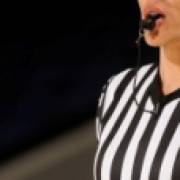I have just completed my annual summer mini-thon of two consecutive weekends of basketball officiating camp, one at UNC Charlotte, the other at Liberty University.

This summer marks my ten year milestone; a decade since I first learned to blow my whistle and feel that rush of adrenalin when the game is stopped and all eyes are on me. This "moment" is always the subject of discussion at camps as instructors remind us over and over again, that officials should NOT be noticed, per se. We are reminded that the perception of the crew is influenced by our "look" from the time we walk on the court, to the time we leave and everything in between. We are coached not only having a strong whistle, strong mechanics and voice, but also on what I'll call dead ball officiating: how to stand during a dead ball, watching warm ups, or during a time out to convey confidence, poise and strength and impartiality. Our facial expressions, use of our hands, body language, posture, handshake, are critiqued and corrected. I was coached this summer primarily on the dead ball aspects of my game, and it is because of this that I know that I am very close to reaching my goal of varsity status.
During pre-game, I am in position across from the visitor bench and observing the players warm up. I am relaxed, but my hands are a little stiff from poor blood circulation as I've been sitting in the stands for the last hour awaiting for my game time to arrive. So, I stretch my hands and fingers a bit by forming a fist, then stretching my fingers in and out several times. At the first time out, the evaluator asks if I am nervous. I say, "no", and he explains that the stretching of my fingers during warms ups give the appearance of nervousness. He then asks me to show him how I stand. I stand with my feet shoulder width apart, balanced on my feet and relaxed. He then responds that I should not be balanced, per se, on both feet, that I look too militaristic; that in fact, it is better to move one leg back a few inches, have my weight back with hands at my side or ideally clasped behind my back. This "look" relays the perception that I am relaxed and approachable. I am coached to stand this way during free throws as well whether I am at the lead position, or center. In fact, while the crew needs to be prepared to come forward, we must position with our weight slightly back, but our front leg ready to move forward.
Being "ambidexterous" - using my left or right arm based on my position relative to the scorer's table - was also emphasized. The better officials instinctively know which arm to use to increase the call's visibility to the scoring table. I am right-handed and tend to use my right arm exclusively. I need to change that. In addition, when an official indicates which direction the ball is going after a call, the official's arm should NOT cross his body. Crossing the body "closes" the body language, looks awkward and may inadvertently "close" your view away from the players. Depending on the situation and the preferences of the evaluator, it might be recommended that the official use the same arm to point direction as the one used to call the foul or violation. At other times, it is recommended that the official use one arm for the call and the other for ball direction. When the evaluators pointed out this aspect of officiating, they referred to it as "polish." I am working on my polish.
Facial expressions when calling a foul or talking to a coach, or simply standing and waiting for the game to begin, must be calm and without any inkling of emotion. I watched a fellow camper during a very fast and physical game call a hard foul under the basket. As he walked away from the location of the players and foul, he had a scowl on his face. This was pointed out by the evaluators and it was clear that he did not realize that he had that expression.
The look to be achieved is expressionless, but engaged. Sound simple? Not really. One official shared a story that during a time out, he and another official came together to talk. Seems they shared a funny story, totally unrelated to the game or even to basketball. They were smiling and laughing. After the game, the officials were called out by the association leadership. Why? Because the coaches and some of the onlookers in the stands believed the officials were laughing at the team. One of the camp evaluators, a high profile and experienced ACC official, makes a point of placing his hands together, finger tips to finger tips, when listening to a coach. He was trained to control his hands in such a way to avoided a confrontational appearance. Even when a coach is angry and may push the official's patience a bit too far, it is recommended verbalize a stern warning to the coach, but NOT put one's hands up. If we need to use our hands to symbolize "stop", we should position the hands waist high, not chest high for the latter has the appearance of being "in the coach's face".
Dead ball officiating, for me, requires concentration and managing how to contain my personality, to some extent. The rule of thumb is to be relaxed, look strong, be friendly, not too friendly, and be yourself. Clear as mud? Sure! no problem, but I guess thats what becoming a varsity official is all about.



















